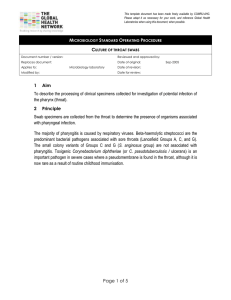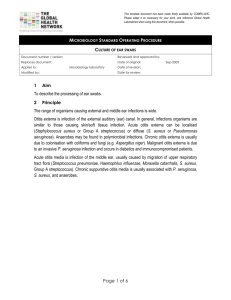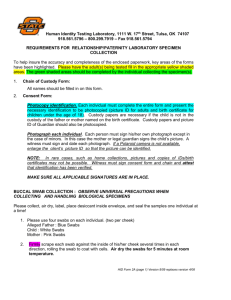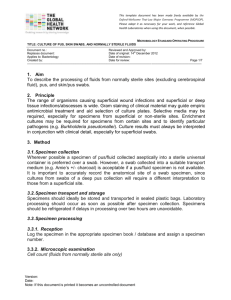Culture of vaginal swabs - Global Health Laboratories
advertisement
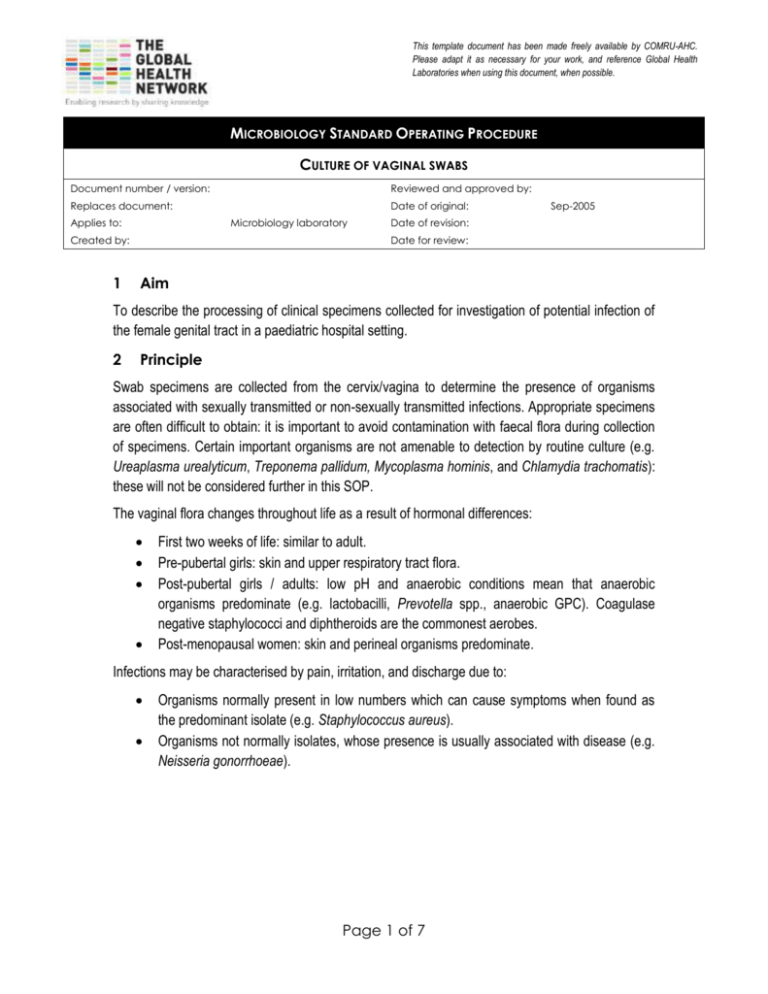
This template document has been made freely available by COMRU-AHC. Please adapt it as necessary for your work, and reference Global Health Laboratories when using this document, when possible. MICROBIOLOGY STANDARD OPERATING PROCEDURE CULTURE OF VAGINAL SWABS Document number / version: Reviewed and approved by: Replaces document: Date of original: Applies to: Microbiology laboratory Created by: 1 Sep-2005 Date of revision: Date for review: Aim To describe the processing of clinical specimens collected for investigation of potential infection of the female genital tract in a paediatric hospital setting. 2 Principle Swab specimens are collected from the cervix/vagina to determine the presence of organisms associated with sexually transmitted or non-sexually transmitted infections. Appropriate specimens are often difficult to obtain: it is important to avoid contamination with faecal flora during collection of specimens. Certain important organisms are not amenable to detection by routine culture (e.g. Ureaplasma urealyticum, Treponema pallidum, Mycoplasma hominis, and Chlamydia trachomatis): these will not be considered further in this SOP. The vaginal flora changes throughout life as a result of hormonal differences: First two weeks of life: similar to adult. Pre-pubertal girls: skin and upper respiratory tract flora. Post-pubertal girls / adults: low pH and anaerobic conditions mean that anaerobic organisms predominate (e.g. lactobacilli, Prevotella spp., anaerobic GPC). Coagulase negative staphylococci and diphtheroids are the commonest aerobes. Post-menopausal women: skin and perineal organisms predominate. Infections may be characterised by pain, irritation, and discharge due to: Organisms normally present in low numbers which can cause symptoms when found as the predominant isolate (e.g. Staphylococcus aureus). Organisms not normally isolates, whose presence is usually associated with disease (e.g. Neisseria gonorrhoeae). Page 1 of 7 This template document has been made freely available by COMRU-AHC. Please adapt it as necessary for your work, and reference Global Health Laboratories when using this document, when possible. MICROBIOLOGY STANDARD OPERATING PROCEDURE CULTURE OF VAGINAL SWABS Document number / version: 3 Method 3.1 Specimen collection Cervical or high vaginal swabs are preferred to lower vaginal swabs. Specimens should be collected using sterile swabs and placed into Amies transport medium (+/- charcoal). 3.2 Specimen transport and storage Specimens should ideally be stored and transported in sealed plastic bags. Laboratory processing should occur as soon as possible after specimen collection. Specimens should be refrigerated if delays in processing over two hours are unavoidable. 3.3 Specimen processing 3.3.1 Reception Log the specimen in the appropriate specimen book and assign a specimen number. 3.3.2 Microscopic examination After inoculating the appropriate agar plates (Section 3.3.3), prepare the following: A thin smear on a clean microscope slide for Gram stain. A wet prep for Trichomonas vaginalis (TV): mix the swab with a drop of sterile saline on a clean microscope slide. Place a coverslip over the wet inoculum and examine with the low power objective. 3.3.3 Culture Inoculate and incubate culture media as indicated in Table 1. Page 2 of 7 This template document has been made freely available by COMRU-AHC. Please adapt it as necessary for your work, and reference Global Health Laboratories when using this document, when possible. MICROBIOLOGY STANDARD OPERATING PROCEDURE CULTURE OF VAGINAL SWABS Document number / version: Table 1. Culture media, conditions, and target organisms Medium Incubation Temp (C) Blood agar 35 - 37 Atmosphere Time 5 - 10% CO2 16 - 24h Cultures read 16 - 24h Target organisms S. aureus Group A, C and G beta-haem streptococci Other organisms may be significant (see section 4) Chocolate agar 35 - 37 5 - 10% CO2 40 - 48h Daily H. influenzae Sabouraud agar 35 - 37 Air 40 - 48h Daily Yeasts GC agar 35 - 37 5 - 10% CO2 40 - 48h Daily N. gonorrhoeae 4 Interpretation Record the semi-quantitative growth of each colony type (i.e. +/- to ++++). 4.1 Minimum level of identification in the laboratory In general significant isolates should be identified as fully as possible: potentially significant organisms are summarised in SOP MID-004. Significant isolates: Group A, C, and G beta-haemolytic streptococci Haemophilus ducreyi Neisseria gonorrhoeae Yeasts: report to the “yeasts” level (not necessary to identify further) Page 3 of 7 This template document has been made freely available by COMRU-AHC. Please adapt it as necessary for your work, and reference Global Health Laboratories when using this document, when possible. MICROBIOLOGY STANDARD OPERATING PROCEDURE CULTURE OF VAGINAL SWABS Document number / version: Other organisms may be significant in certain settings: Group B beta-haemolytic streptococcus: do antimicrobial susceptibilities and report only if clinical details state that the patient is pregnant. Coliforms: identify, do antimicrobial susceptibilities and report only if heavy pure growth. If heavy and mixed, report as “heavy growth of coliforms” and do not perform antimicrobial susceptibilities. S. aureus: do antimicrobial susceptibilities and report only if heavy or pure growth. Upper respiratory tract flora (Haemophilus influenzae and Streptococcus pneumoniae): do antimicrobial susceptibilities and report only if heavy or pure growth. 4.2 Antimicrobial susceptibility testing All significant isolates should have antimicrobial susceptibilities determined according to SOP MIC001. 4.3 Reporting Gram stain results: WBC and organisms detected. The presence of intra-cellular Gram negative diplococci should be communicated to the clinician urgently. Wet prep results: presence or absence of Trichomonas vaginalis (note presence of parasite ova if seen incidentally). Culture results: presence of significant isolates (e.g. N. gonorrhoeae); no significant growth / mixed growth of doubtful significance may be used; absence of growth. 5 Quality assurance Media and identification tests should be quality controlled according to the relevant SOP. 6 Limitations Prior antimicrobial use may result in negative cultures. 7 References 1. Health Protection Agency, UK SOP B24: Investigation of Genital Tract and Associated Specimens (Issue 4.3; December 2012). 2. Hawkey, P and Lewis, D. Medical Bacteriology. 2nd Edition (2004). Oxford University Press. Page 4 of 7 This template document has been made freely available by COMRU-AHC. Please adapt it as necessary for your work, and reference Global Health Laboratories when using this document, when possible. MICROBIOLOGY STANDARD OPERATING PROCEDURE CULTURE OF VAGINAL SWABS Document number / version: 8 Synopsis / Bench aid Page 5 of 7 This template document has been made freely available by COMRU-AHC. Please adapt it as necessary for your work, and reference Global Health Laboratories when using this document, when possible. MICROBIOLOGY STANDARD OPERATING PROCEDURE CULTURE OF VAGINAL SWABS Document number / version: Page 6 of 7 This template document has been made freely available by COMRU-AHC. Please adapt it as necessary for your work, and reference Global Health Laboratories when using this document, when possible. MICROBIOLOGY STANDARD OPERATING PROCEDURE CULTURE OF VAGINAL SWABS Document number / version: 9 Risk assessment COSHH risk assessment - University of Oxford COSHH Assessment Form Description of procedure Culture of genital swabs Substances used Variable, depending on organism cultured (may include Gram stain reagents; 3% hydrogen peroxide (catalase test); N,N,N',N'-tetramethyl-1,4phenylenediamine (oxidase test); sodium deoxycholate (bile solubility test); bioMerieux API reagents) Quantities of chemicals used Frequency of SOP use Small Daily Hazards identified Could a less hazardous substance be 1. Autoclaved liquid used instead? 2. Potentially infectious material in sample No 3. Potentially pathogenic bacteria 4. Chemical exposure form bacterial identification tests What measures have you taken to control risk? 1. Training in good laboratory practices (GLP) 2. Appropriate PPE (lab coat, gloves, eye protection) 3. Use of biosafety cabinet for reading of plates / follow-up of BSL-3 organisms (e.g. B. pseudomallei) Checks on control measures Observation and supervision by senior staff Is health surveillance required? Training requirements: No GLP Emergency procedures: Waste disposal procedures: 1. Report all incidents to Safety Adviser 1. Sharps discarded into appropriate rigid 2. Use eyewash for splashes containers for incineration 3. Clean up spills using 1% Virkon or 2. Infectious waste discarded into autoclave bags chemical spill kit or 1% Virkon solution prior to autoclaving and subsequent incineration 3. Chemical waste disposed of according to manufacturer’s instructions Page 7 of 7

